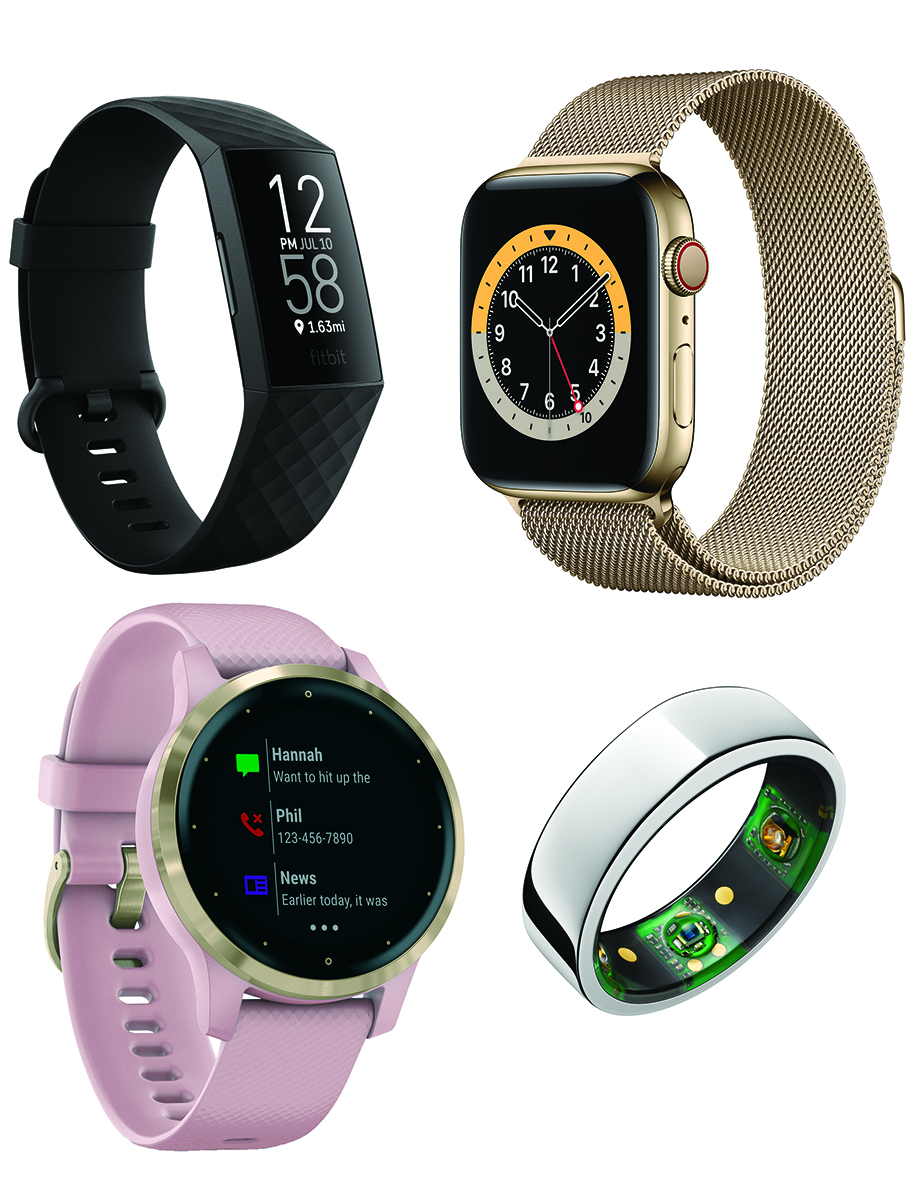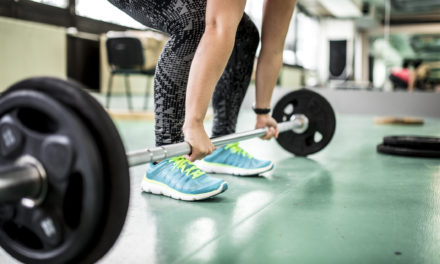Wearable fitness trackers are becoming more capable and comprehensive in providing real-time data that can drive health decisions. Now doctors are utilizing them to help patients stay on top of their medical needs.
When our desire to monitor our fitness goals first synced up with technology, we used the pedometer to keep track of our steps. The widespread use of a wearable step counter—and that 10,000 step-per-day goal—goes back to a marketing campaign to sell pedometers in Japan during the 1960s. The impulse to monitor ourselves has only intensified in the decades since, and the technology used to do so has also rapidly advanced.
Over the past year, fitness trackers have received renewed attention for their possible ability to alert people to COVID-19 in the body before symptoms appeared. Last summer, the NBA outfitted players with Oura Rings, vital-signs monitors that are worn on your fingers, after a West Virginia University study showed the trackers to be 90 percent accurate at spotting COVID 3 days ahead of symptoms.
Last year, a study from the Scripps Research Translational Institute showed that data drawn from fitness trackers can signal an emerging outbreak of flu-type viruses. In the future, a tracker could be used as a warning system, alerting you that you should quarantine and call your doctor.
While the public health potential of wearable trackers has yet to be fully realized, individuals can certainly use these powerful tech toys to improve their personal health. Today’s wearable trackers go well beyond counting your steps. They can detect your heartbeat, read your skin’s temperature, and evaluate your sleep quality. They’re incredibly effective tools for enhancing athletic performance as well as reducing stress. “[A fitness tracker] can even potentially help you avoid a life-ending or life-altering heart attack or stroke,” says Harit Desai, DO, a cardiologist with Capital Health.
A Heart Health Helper
Jennifer Dougherty, 50, of Lumberton NJ, has been wearing her Apple Watch ever since her heart attack 2 years ago. “It came as a total shock. My BMI was low to normal, and I’ve always maintained a low-sodium, low-fat diet. I wasn’t on any cholesterol or blood pressure medication, and my numbers had always been good,” she says.
After her heart attack, she wanted to reduce her chances of any more surprises, so she turned to a tracker. It can detect warning signals like an irregular heart rhythm or potential sleep apnea. “A tracker like the Apple Watch can even spot atrial fibrillation. Then doctors can perform the right interventions to avoid the blood clots, stroke, heart failure, and other heart-related complications that can happen,” says Dr. Desai. Untreated, atrial fibrillation doubles your risk of heart-related death and increases your stroke risk fivefold, according to the American Heart Association.
Luckily, Dougherty’s tracker has never sounded the alarm for an impending health emergency. “The number-one way I use it on a day-to-day basis is for stress,” she says. “Over time, I’ve noticed when I’m working my heart rate seems to be higher and it’s lower on the weekends.” In an effort to reduce stress on the job, she installed the Breathe app on Apple Watch. The app guides you through a simple mindfulness breathing exercise. The watch’s display shows a flower expanding to cue you to inhale and shrinking to cue you to exhale. It mutes stress-inducing notifications while you’re using the app. You can tell if it’s working by comparing your before and after heart rates, also displayed on the watch. “I know it’s time to use the Breathe app when my heart rate gets to be 90 or 100 beats per minute. Usually, it helps me bring it down to 60 or 70 beats per minute,” Dougherty explains.
She’s also started setting aside some time each night for a self-styled stretching and meditation session. She uses the Headspace app and does some gentle yoga to ease tension in her body and bring her heart rate down to relax before bed. The watch indicates it has improved her sleep quality. “Really, my watch holds me accountable. Being able to track and have this data that can show me trends over time is helpful,” says Dougherty.
A tracker like the Apple Watch can even spot atrial fibrillation. Then doctors can perform the right interventions to avoid blood clots, stroke, heart failure, and other heart-related complications that can happen.
Handy Little Numbers
This attractive smartwatch/fitness tracker combo gives you all the health monitoring you could want, plus the ability to play music and even follow along with on-screen fitness animations. It’s a favorite among runners. Like most devices in this category, the cost is the biggest drawback. $349.99
This is a great tracker, at a lower price point. It monitors your heart rate, sleep, breathing, and more. If you are looking for a true smartwatch that can run apps and receive messages, you may want to look elsewhere. $149.95
This device rules the category. It can measure your blood oxygen or give you an electrocardiogram on demand. It also tracks your workouts and other daily activities. However, it’s among the most expensive options out there, and it may not be a fit for those who don’t use other Apple devices. $399 and up
$99 to $399
This device tracks your active and inactive times during the day, but its real value is what it tells you while you sleep: your resting heart rate, heart rate variability, and how much of each sleep stage you’re getting (light, deep, and REM). It does not offer GPS functionality.

Putting on the Wrist
Of course, the most common reason people use wearable trackers remains fitness. A running enthusiast, Malvern-based Kim Kokolus, 36, has used a fitness tracker as a central part of her race training for the past 2 years. “I got the Garmin 645 for Mother’s Day, and the heart rate piece has completely changed things for me,” she says. “Using it has helped me understand how to reach my athletic potential.”
When she’s training, she uses heart rate zones to get fitter over time. Target heart rate zones are based on the idea that during training you should be working at 50 percent to 85 percent of your average maximum heart rate, which you can estimate by subtracting your age from 200. Some trackers, including the Garmin, use a color-coded system for heart rate zones. “You don’t want to hang out in that hard exercise zone too much—you should only be there about 25 percent of your workout,” says Dr. Desai. The rest of the time, you want to be in a more moderate range. “Without a heart rate monitor, you are totally in the dark,” says Dr. Desai.
This can not only protect your heart from the strain of ongoing overexertion, but it can also really make your training more effective. “It helps me figure out if I should be working out harder, and it tells me when I need a rest day tomorrow,” says Kokolus. “If my tacker shows me that I’m in a moderate zone but I feel like I’m dying, I know I need a day off.” Ultimately, taking appropriate rest helps athletes get stronger and faster.
Conversely, if you aren’t a fitness buff, a tracker tells you if you’re working too hard for your fitness level and need to back off. When it comes to fitness, Dougherty doesn’t train the way Kokolus does. She mostly relies on her tracker to keep moderately active and avoid too much sitting throughout the day. “When I do exercise, I make sure I’m in a certain heart rate range,” she says.
Kokolus also uses her tracker to ensure she isn’t sedentary on days she doesn’t work out. “The step tracker does keep me active during rest days,” she says. She also uses her Garmin’s calorie counter functionality. She credits the device with helping her lose 35 pounds and keep it off. But she’s even more proud of the performance gains her tracker has helped her achieve.
“Since I started using my Garmin, I’ve gone from running a 10-minute mile to an 8.45-minute mile, and I’ve increased my ability to run longer distances. My standard for a good run used to be 2 miles, and now it’s more like 5 miles,” she says.
Drive-By Data
During the pandemic, on a collective level, advances in tracker technology have allowed scientists to see new potential for tracking, tracing, and predicting future disease outbreaks thanks to all the data these devices collect. But on an individual level, Dr. Desai says he’s noticed many of his patients becoming more sedentary and more stressed. “People have been gaining weight as they’ve transitioned to working from home and become less active,” he says. One of the simplest and biggest benefits of wearable fitness trackers is that they remind you to simply get up and move around.
Not everyone can afford one of these high-tech trackers, but anyone can set an alarm to go off periodically throughout the day as a reminder to stand up, take a walk, or just breathe. Whether you have a tracker or not, Dr. Desai’s advice is to take time to take care of yourself. “In general, women put everything else ahead of themselves, and that leads to even more stress. If nothing else, do 10 minutes of meditation,” he says. “If you can also add some exercise, that would be great.”





